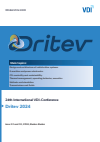Dritev 2024
Zusammenfassung
Content E-engine Comparison of technologies and materials for E-Drive systems under new cooling aspects 1 Drive concept Valeo new high voltage Xin1 eAxle range A modular and scalable approach from 40 kW to 300 kW 35 New efficiency, cost, and space advantages of highly integrated xONEdrive solutions 47 Transmission High Reduction Hypoids High ratio, high speed and also high efficiency? 53 Gear Efficiency Optimization - Macro and Micro Geometry Design for Stepped Planetary Gear Stages 69 From single contact to mechatronic system – examples of series applications of planetary roller gears in automobiles 87 Merits of using harmonic current injection in electric drives to reduce torque ripple, improve NVH behavior, and more 103 On the effects of electric components on gearbox noises 117 Content3D tolerance analysis of gear components Optimized design of tolerance positions considering noise emission due to gear mesh 125 Simulation Parameter Study on the Influence of Driving Cycle and Powertrain Parameterization on Fuel Consumption of wheel-hub driven Vehicles 141 A MBSE approach ...
Schlagworte
- Kapitel Ausklappen | EinklappenSeiten
- I–X Titelei/Inhaltsverzeichnis I–X
- 1–34 E-engine 1–34
- Comparison of technologies and materials for E-Drive systems under new cooling aspects
- 35–52 Drive concept 35–52
- 35–46 Valeo new high voltage Xin1 eAxle range A modular and scalable approach from 40 kW to 300 kW 35–46
- 47–52 New efficiency, cost, and space advantages of highly integrated xONEdrive solutions 47–52
- 53–102 Transmission 53–102
- 53–68 High Reduction Hypoids – High ratio, high speed and also high efficiency? 53–68
- 69–86 Gear Efficiency Optimization - Macro and Micro Geometry Design for Stepped Planetary Gear Stages 69–86
- 87–102 From single contact to mechatronic system – examples of series applications of planetary roller gears in automobiles 87–102
- 103–140 NVH 103–140
- 103–116 Merits of using harmonic current injection in electric drives to reduce torque ripple, improve NVH behavior, and more 103–116
- 117–124 On the effects of electric components on gearbox noises 117–124
- 125–140 3D tolerance analysis of gear components: Optimized design of tolerance positions considering noise emission due to gear mesh 125–140
- 141–184 Simulation 141–184
- 141–158 Parameter Study on the Influence of Driving Cycle and Powertrain Parameterization on Fuel Consumption of wheel-hub driven Vehicles 141–158
- 159–174 A MBSE approach for Virtual Verification & Validation of E-Drives with Digital Twins 159–174
- 175–184 Improving Energy & Motion Control Functions through Higher System Integration in the Software-Defined Vehicle 175–184
- 185–192 Cooling/Fluids 185–192
- Efficient and sustainable dielectric fluids for direct battery and e-motor cooling – Enhancing range, lifetime, and safety
- 193–234 Thermal management 193–234
- 193–212 Efficiency Improvement Potential of a BEV Gearbox using a Mono Fluid Circuit 193–212
- 213–218 Testing, Simulation and Validation for Designing Battery Safety Materials 213–218
- 219–234 Development of efficient thermal management systems for HEVs, BEVs and FCEVs using Co-simulation on the HiL-ThermoLab testbed 219–234
- 235–282 Hybrid 235–282
- 235–242 The next Audi 48V hybrid powertrain generation with an Integrated Electric Drive System 235–242
- 243–250 Design of a 48V Integrated Electric Drive System 243–250
- 251–264 The new STELLANTIS EDCT P2 hybrid transmission scalable for both 48V/320V Stellantis hybrid models application 251–264
- 265–282 Dedicated Hybrid Transmissions (DHT) in modern mobility and the future-proof hybrid strategy for multi-modes powertrains 265–282
- 283–336 AI methods 283–336
- 283–302 Thermal Digital Twin using Reduced Order Model (ROM) and Artificial Intelligence (AI) in High Voltage Power Electronics of Electric Vehicles 283–302
- 303–316 Optimization of the Electric Powertrain using Machine Learning Methods 303–316
- 317–330 Develop efficiently and save resources with engineering AI and the Robust Design method – Practical examples on NVH, inverter and battery 317–330
- 331–336 Quality Improvement through AI-based Usage of Production and Field Data Analysis 331–336
- 337–368 Transmission 2 337–368
- 337–358 Driving dynamics optimization of electrically powered vehicles by means of active limited slip differentials 337–358
- 359–368 Ultra Compact Drive – future development of co-axial solution with Integrated Differential 359–368
- 369–396 Sustainability 369–396
- 369–382 The path to a CO2-neutral steel component proof of concept at Richard Neumayer GmbH 369–382
- 383–396 Carbon Footprint Minimization of Electric Powertrains by Multi-Objective Design Optimization 383–396
- 397–404 E-engine 2 / Inverter 397–404
- Automated Design Optimization of Axial and Radial Flux Motors for E-powertrains
- 405–428 Drive concept 2 405–428
- 405–406 Customized EDU systems from micro mobility to heavy-duty applications 405–406
- 407–414 Magna’s Next-Gen eDrive Portfolio 407–414
- 415–428 The innovative cooling system of the new ID.7 electric drive 415–428
- 429–XIV Inverter 2 429–XIV
- 429–444 Non-isolated onboard charger with three-phase and single-phase operation mode and increased power density 429–444
- 445–456 Trends for ultra compact inverters in e-drive systems – Next generation inverter 445–456
- 457–XIV Efficiency increase of electric drives by use of multilevel inverters and permanent magnet synchronous motors. 457–XIV


